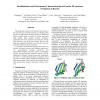Free Online Productivity Tools
i2Speak
i2Symbol
i2OCR
iTex2Img
iWeb2Print
iWeb2Shot
i2Type
iPdf2Split
iPdf2Merge
i2Bopomofo
i2Arabic
i2Style
i2Image
i2PDF
iLatex2Rtf
Sci2ools
86
Voted
IPPS
2006
IEEE
2006
IEEE
Parallelization and performance characterization of protein 3D structure prediction of Rosetta
The prediction of protein 3D structure has become a hot research area in the post-genome era, through which people can understand a protein’s function in health and disease, explore ways to control its actions and assist drug design. Many protein structure prediction approaches have been proposed in past decades. Among them, Rosetta is one of the best systems. However, the huge time complexity of Rosetta, e.g. a few days to predict a protein, limits its wide use in practice. To accelerate the prediction of protein 3D structure in Rosetta, this paper presents three different approaches, i.e., non-interactive, periodic interactive and asynchronous dynamic interactive scheme, to parallelize Rosetta. The asynchronous interactive scheme, with the adaptation of dynamic solution interaction, outperforms the other two, delivering much faster convergence speed and better solution quality. Detailed measurements and performance analysis also indicate that parallel Rosetta with asynchronous dyn...
Distributed And Parallel Computing | Dynamic Interactive Scheme | IPPS 2006 | Protein 3D Structure | Protein Structure Prediction |
| Added | 12 Jun 2010 |
| Updated | 12 Jun 2010 |
| Type | Conference |
| Year | 2006 |
| Where | IPPS |
| Authors | Wenlong Li, Tao Wang, Eric Li, D. Baker, Li Jin, Steven Ge, Yurong Chen, Yimin Zhang |
Comments (0)

